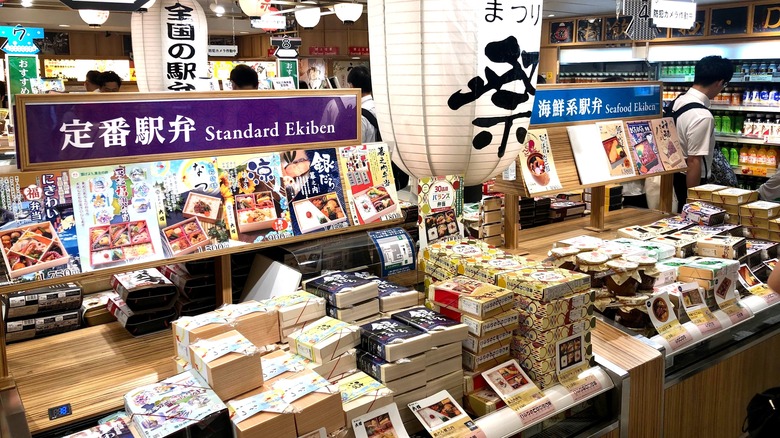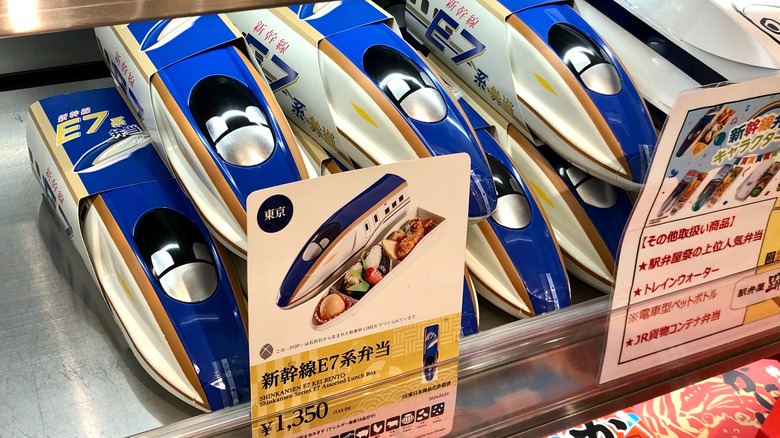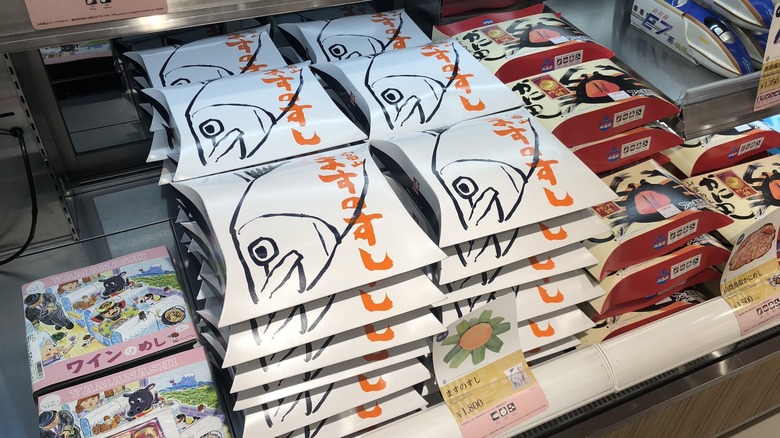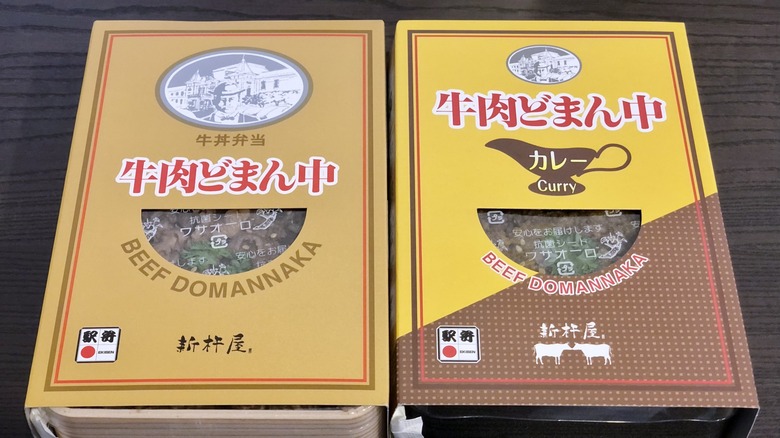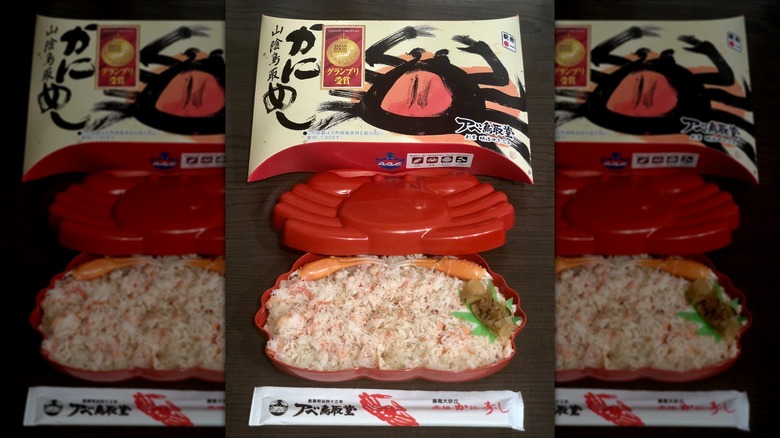The Best Train Station Bento Boxes For Your Journey Across Japan
In Japan, boarding the bullet train with a bento box you've bought in the station is a time-honored ritual for lunch-on-the-go. These ready-made meals allow travelers to dine on different regional specialties as they're riding a high-speed train — also known as the shinkansen — between unmissable Japanese tourist destinations like Kyoto and Hiroshima. The trains have airplane-style seats, but with more leg room. When you sit down, you can unfold a tray table in your lap before unwrapping your ekiben (station bento) like a little gift to your stomach. It helps to know what food's inside and which region the box hails from so you can pick out the right one for your travels.
I've lived in Japan since 2010, and I've crisscrossed the country many times while writing about travel destinations here for domestic media outlets like Japan Today and GaijinPot. If you're ever in Nagaoka or Tokushima, you might see some English-language signs and museum placards I edited for a project with the government-run Japan Tourism Agency. Whenever possible, I'll ride the bullet train or a limited express train instead of flying to such places.
The reason for that is simple: It's easier to hop on the train than go through all the hassle of a trip out to the airport. As a result, I've had many opportunities to scout train station stores for different regional bento. Here are a few of the more interesting ones to look out for in the station on your next trip to Japan.
Bullet train and Tokyo Station themed bento
The Tokaido Shinkansen, Japan's original bullet train route, has been running between Tokyo and Shin-Osaka since 1964 — the year the capital hosted its first Olympics. Tokyo Station is also a good starting point for a bento-infused culinary tour of Japan. In the old days, you would only be able to find certain regional bento in the local station where they originated. Nowadays, it's easier to find them in department store fairs and satellite station stores like Ekiben-ya Matsuri.
Centrally located inside the ticket gates at Tokyo Station, Ekiben-ya Matsuri sells bento varieties from all over Japan (including the ones on this list). Kids and railfans alike will get a kick out of the Shinkansen E7 Kei Bento, where your food comes packaged in a reusable plastic box that's shaped like a bullet train. Inside, the souvenir train is packed with goodies like onigiri (rice balls) and karaage (boneless fried chicken).
The Tokyo Bento might be worth it if only for the eye-catching wrapper with the station's red-brick façade on it. Not to be outdone, the Tokyo Station Hotel has its own prize-winning bento with a gold wrapper befitting the hotel's luxury prices. The name, Niku Zanmai, even translates as "meat luxury," much like Tokyo's popular Sushi Zanmai chain advertises "sushi luxury." Here, the meat includes chicken, pork, and black wagyu beef with locally brewed soy sauce, served over a bed of rice. The hotel's executive chef oversaw the Niku Zanmai bento's creation.
Trout pressed sushi from Toyama
When people think "Japanese food," sushi is probably one of the first things that comes to mind, but when I think "station bento," it's sushi pie. That's one way to conceptualize what awaits you when you unbox your bento from Masu no Sushi. Inside, there's a round wooden container with an uncut trout sushi wheel, wrapped in bamboo leaves. You can cut it into slices with a plastic knife and share it with one or more traveling companions. The single-serving version comes in a smaller, rectangular box with more traditionally shaped sushi pieces.
The trout is layered on top of vinegared rice in a pressed sushi, or oshizushi, style that originated in the food haven of Osaka. However, Masu no Sushi is a specialty of Toyama Prefecture, which is 2.5 hours northeast of Osaka via the JR Limited Express Thunderbird and Hokuriku Shinkansen. This prefecture is home to the impressive Tateyama Snow Corridor and Shirakawa-go, the picture-perfect Japanese village for a winter vacation.
You can find Masu no Sushi in Toyama Station, where it's been since 1908. In Tokyo, I've even seen my local supermarket, Keio Store, selling it on occasion. Every January, Keio Department Store holds an Ekiben Fair in Shinjuku, Tokyo, where you can get regional bento like Masu no Sushi outside the station setting. Shinjuku Station also has a bento bazaar, Ekiben-ya Itadaki, open year-round. Look for the cardboard envelope with a big, black-and-white fish head on it. That's Masu no Sushi.
Yonezawa beef and hot Sendai beef tongue
There's such a wide variety of station bento boxes that it takes a lot for one to distinguish itself, but that's what Beef Domannaka did when it won the second Ekiben Grand Prix in 2013. Yamagata Prefecture is known for its wagyu beef and Domannaka rice, along with tourist attractions like the volcanic crater lake on Mount Zao. This boxed-up brand of beef over rice from the city of Yonezawa puts the ingredients together. It's essentially a better-quality version of the beef bowls served nationwide at chains like Yoshinoya.
In 2023, Beef Domannaka took runner-up in the Ekiben Grand Prix with a tasty new curry-flavored recipe. Aside from its home base in Yonezawa Station, you can find this bento brand in places like the aforementioned Ekiben-ya Matsuri shop in Tokyo Station. Its Beef Ekiben section has various Kobayashi Gyutan Bento boxes. Gyutan means "beef tongue."
Yes, you'll be eating some cow tongue over rice; try not to think about it. Focus instead on the novelty of a self-heating bento box, where you can pull a string and then sit back as your pre-cooked rice, topped with charcoal-grilled meat, warms back up. Recently, I'm partial to the spicy Beef Tongue Sagari Pepper & Rice box. Bento like it come to the capital from Sendai Station in Miyagi Prefecture. With shopping arcades decked out in colorful streamers, the city of Sendai is famous for hosting the biggest Tanabata (Star Festival) celebration in Japan every August.
Tottori crab rice and Hokkaido squid rice
In a country where seafood is prevalent — and a benighted tourist could confuse fried squid rings for curly fries — it seems appropriate to end on kanimeshi (crab rice) and ikameshi (squid rice). The former hails from Tottori Prefecture, where you might forget you're in Japan as you pose with a camel, seaside, in front of the Tottori Sand Dunes. In 2024, the nearby Sand Museum is running a France-themed exhibition of sand sculptures in honor of the Paris Olympics. It's a cardboard box decorated with a crab, however, that represents Tottori and the San'in Region in station bento stores.
Inside the San'in Tottori Kanimeshi bento, you'll find another red plastic box shaped like an actual crab. It holds rice topped with red snow crab meat and two crab claws. In 2023, this was one of the bento to win Japan Food Selection's Grand Prix with a score of 90 to 100, based on a survey of 23,000 qualified food analysts.
If you're feeling adventurous, you could give Ikameshi a try. This bestselling bento from Mori Station in Hokkaido just consists of two small stuffed squid. Don't be put off by their slimy texture; it's no stranger than snacking on raw, crunchy firefly squid from Toyama in springtime. Once you bite into Ikameshi, you may be surprised how delicious the rice filling, simmered in soy sauce, is. Pair it with a box of Masu no Sushi, and you've got yourself a good train meal.
